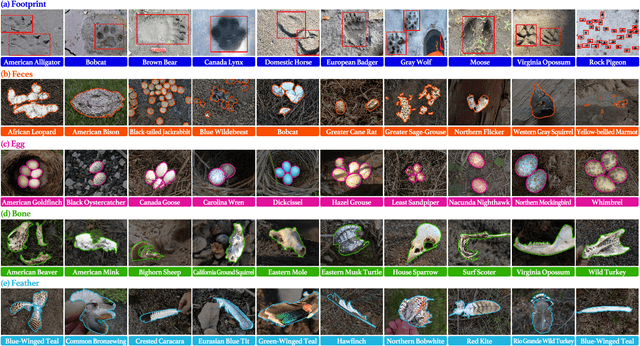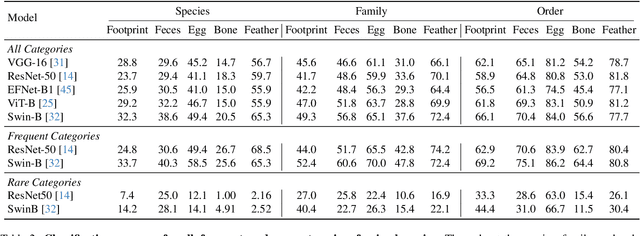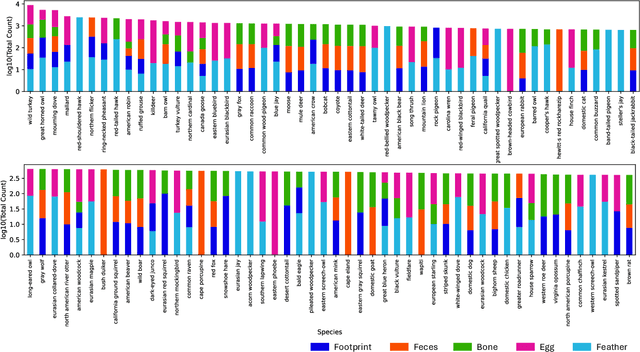Risa Shinoda
Zero-shot Hierarchical Plant Segmentation via Foundation Segmentation Models and Text-to-image Attention
Sep 11, 2025Abstract:Foundation segmentation models achieve reasonable leaf instance extraction from top-view crop images without training (i.e., zero-shot). However, segmenting entire plant individuals with each consisting of multiple overlapping leaves remains challenging. This problem is referred to as a hierarchical segmentation task, typically requiring annotated training datasets, which are often species-specific and require notable human labor. To address this, we introduce ZeroPlantSeg, a zero-shot segmentation for rosette-shaped plant individuals from top-view images. We integrate a foundation segmentation model, extracting leaf instances, and a vision-language model, reasoning about plants' structures to extract plant individuals without additional training. Evaluations on datasets with multiple plant species, growth stages, and shooting environments demonstrate that our method surpasses existing zero-shot methods and achieves better cross-domain performance than supervised methods. Implementations are available at https://github.com/JunhaoXing/ZeroPlantSeg.
AgroBench: Vision-Language Model Benchmark in Agriculture
Jul 28, 2025Abstract:Precise automated understanding of agricultural tasks such as disease identification is essential for sustainable crop production. Recent advances in vision-language models (VLMs) are expected to further expand the range of agricultural tasks by facilitating human-model interaction through easy, text-based communication. Here, we introduce AgroBench (Agronomist AI Benchmark), a benchmark for evaluating VLM models across seven agricultural topics, covering key areas in agricultural engineering and relevant to real-world farming. Unlike recent agricultural VLM benchmarks, AgroBench is annotated by expert agronomists. Our AgroBench covers a state-of-the-art range of categories, including 203 crop categories and 682 disease categories, to thoroughly evaluate VLM capabilities. In our evaluation on AgroBench, we reveal that VLMs have room for improvement in fine-grained identification tasks. Notably, in weed identification, most open-source VLMs perform close to random. With our wide range of topics and expert-annotated categories, we analyze the types of errors made by VLMs and suggest potential pathways for future VLM development. Our dataset and code are available at https://dahlian00.github.io/AgroBenchPage/ .
AnimalClue: Recognizing Animals by their Traces
Jul 27, 2025



Abstract:Wildlife observation plays an important role in biodiversity conservation, necessitating robust methodologies for monitoring wildlife populations and interspecies interactions. Recent advances in computer vision have significantly contributed to automating fundamental wildlife observation tasks, such as animal detection and species identification. However, accurately identifying species from indirect evidence like footprints and feces remains relatively underexplored, despite its importance in contributing to wildlife monitoring. To bridge this gap, we introduce AnimalClue, the first large-scale dataset for species identification from images of indirect evidence. Our dataset consists of 159,605 bounding boxes encompassing five categories of indirect clues: footprints, feces, eggs, bones, and feathers. It covers 968 species, 200 families, and 65 orders. Each image is annotated with species-level labels, bounding boxes or segmentation masks, and fine-grained trait information, including activity patterns and habitat preferences. Unlike existing datasets primarily focused on direct visual features (e.g., animal appearances), AnimalClue presents unique challenges for classification, detection, and instance segmentation tasks due to the need for recognizing more detailed and subtle visual features. In our experiments, we extensively evaluate representative vision models and identify key challenges in animal identification from their traces. Our dataset and code are available at https://dahlian00.github.io/AnimalCluePage/
SBS Figures: Pre-training Figure QA from Stage-by-Stage Synthesized Images
Dec 23, 2024



Abstract:Building a large-scale figure QA dataset requires a considerable amount of work, from gathering and selecting figures to extracting attributes like text, numbers, and colors, and generating QAs. Although recent developments in LLMs have led to efforts to synthesize figures, most of these focus primarily on QA generation. Additionally, creating figures directly using LLMs often encounters issues such as code errors, similar-looking figures, and repetitive content in figures. To address this issue, we present SBSFigures (Stage-by-Stage Synthetic Figures), a dataset for pre-training figure QA. Our proposed pipeline enables the creation of chart figures with complete annotations of the visualized data and dense QA annotations without any manual annotation process. Our stage-by-stage pipeline makes it possible to create diverse topic and appearance figures efficiently while minimizing code errors. Our SBSFigures demonstrate a strong pre-training effect, making it possible to achieve efficient training with a limited amount of real-world chart data starting from our pre-trained weights.
PetFace: A Large-Scale Dataset and Benchmark for Animal Identification
Jul 18, 2024Abstract:Automated animal face identification plays a crucial role in the monitoring of behaviors, conducting of surveys, and finding of lost animals. Despite the advancements in human face identification, the lack of datasets and benchmarks in the animal domain has impeded progress. In this paper, we introduce the PetFace dataset, a comprehensive resource for animal face identification encompassing 257,484 unique individuals across 13 animal families and 319 breed categories, including both experimental and pet animals. This large-scale collection of individuals facilitates the investigation of unseen animal face verification, an area that has not been sufficiently explored in existing datasets due to the limited number of individuals. Moreover, PetFace also has fine-grained annotations such as sex, breed, color, and pattern. We provide multiple benchmarks including re-identification for seen individuals and verification for unseen individuals. The models trained on our dataset outperform those trained on prior datasets, even for detailed breed variations and unseen animal families. Our result also indicates that there is some room to improve the performance of integrated identification on multiple animal families. We hope the PetFace dataset will facilitate animal face identification and encourage the development of non-invasive animal automatic identification methods.
OpenAnimalTracks: A Dataset for Animal Track Recognition
Jun 14, 2024Abstract:Animal habitat surveys play a critical role in preserving the biodiversity of the land. One of the effective ways to gain insights into animal habitats involves identifying animal footprints, which offers valuable information about species distribution, abundance, and behavior. However, due to the scarcity of animal footprint images, there are no well-maintained public datasets, preventing recent advanced techniques in computer vision from being applied to animal tracking. In this paper, we introduce OpenAnimalTracks dataset, the first publicly available labeled dataset designed to facilitate the automated classification and detection of animal footprints. It contains various footprints from 18 wild animal species. Moreover, we build benchmarks for species classification and detection and show the potential of automated footprint identification with representative classifiers and detection models. We find SwinTransformer achieves a promising classification result, reaching 69.41% in terms of the averaged accuracy. Faster-RCNN achieves mAP of 0.295. We hope our dataset paves the way for automated animal tracking techniques, enhancing our ability to protect and manage biodiversity. Our dataset and code are available at https://github.com/dahlian00/OpenAnimalTracks.
SegRCDB: Semantic Segmentation via Formula-Driven Supervised Learning
Sep 29, 2023



Abstract:Pre-training is a strong strategy for enhancing visual models to efficiently train them with a limited number of labeled images. In semantic segmentation, creating annotation masks requires an intensive amount of labor and time, and therefore, a large-scale pre-training dataset with semantic labels is quite difficult to construct. Moreover, what matters in semantic segmentation pre-training has not been fully investigated. In this paper, we propose the Segmentation Radial Contour DataBase (SegRCDB), which for the first time applies formula-driven supervised learning for semantic segmentation. SegRCDB enables pre-training for semantic segmentation without real images or any manual semantic labels. SegRCDB is based on insights about what is important in pre-training for semantic segmentation and allows efficient pre-training. Pre-training with SegRCDB achieved higher mIoU than the pre-training with COCO-Stuff for fine-tuning on ADE-20k and Cityscapes with the same number of training images. SegRCDB has a high potential to contribute to semantic segmentation pre-training and investigation by enabling the creation of large datasets without manual annotation. The SegRCDB dataset will be released under a license that allows research and commercial use. Code is available at: https://github.com/dahlian00/SegRCDB
 Add to Chrome
Add to Chrome Add to Firefox
Add to Firefox Add to Edge
Add to Edge